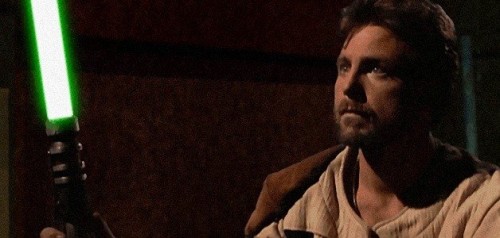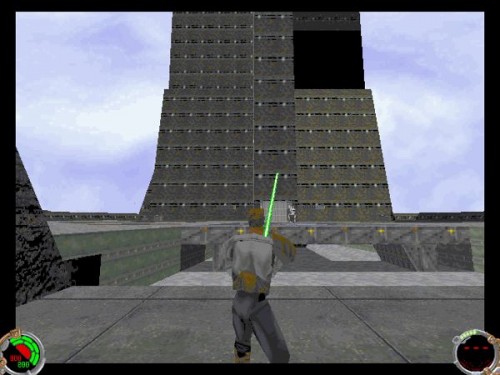
Welcome to the first entry in the new Netbook Gamer series! In the fall of 1997 LucasArts delivered into the hands of gamers something they had wanted since they first saw one twenty years prior – a lightsaber.
Dark Forces brought the Star Wars universe a new level of immersion through the first person shooter perspective. The story brought in classic settings abd characters and introduced a new hero – Kyle Katarn. Former Imperial Academy hero shaken by the discovery of the nature of the Empire through tragic events, Katarn is joined by his partner Jan Ors as the pair serve as mercenaries in the hire of the Rebellion. Dark Forces was an amazing game that delivered a visceral experience and new technical advances to the new first person shooter genre. What it didn’t give gamers was a taste of what it felt like to be a Jedi.
It took a couple of years for that vision to be realized, but the results were well worth the wait: Jedi Knight was critically heralded at release and remains an amazing game in terms of gameplay, characters and story. It is a game that I have installed on every PC I have owned ever since and have played a minimum of once a year until today. I had already played the game once this year on my netbook, but to commemorate the release of the game on Steam, I played through it again.
The first thing you will notice is the FMV (Full Motion Video) introduction and opening cutscene, which is shown in the screenshot at the top of the article. This was fairly common at the time, and the early move to CGI cutscenes was bemoaned due to the excellent scenes from games such as Command & Conquer and Jedi Knight. Jason Court’s representation has become Kyle Katarn, as the characterizations from Jedi Outcast and Jedi Academy attempted to capture that spirit in digital form.
The next thing you’ll notice was equally common – dropping from FMV to the game engine graphics is quite jarring. Obviously ten years later even a modest computer like a netbook can run the game with all settings maximized – indeed, the game engine was able to scale up to run the game at 1900×1200 pixels. Even at those settings the game looks primitive, so I tried running at lower setting to imagine how it would look on a mid-range computer at the time. Here are a couple of screens to compare, with the top screen representing a solid 1997 PC and the lower one from my netbook:


Those screens show how well the engine scales in terms of filling details and resolving characters, but also shows that the limitations take over well before the capabilities of a low-end integrated graphics card kick in.
But the amazing thing about the game isn’t the graphics – it is the story and gameplay. The story is fairly simple yet allows for the introduction of a set of characters that makes for a compelling game from start to finish. As the Empire is falling apart after the destruction of the second Death Star, many seek to grab power and control the galaxy. One of these is Jerec, a Dark Jedi – not a Sith, but a former Jedi who has turned to the Dark Side of the Force. He has taken on several proteges, and some of these are training apprentices. They will try to destroy you and ensure that Jerec can reach his goal – the fabled Valley of the Jedi, whose power could allow him to gain ultimate power in the galaxy.
This sets the basic structure of gameplay: you play through a series of levels against common Star Wars enemies – Rodians, Grans, and of course wave after wave of Stormtroopers. Then you reach a face-off against one of the Jedi. You start with Yun, who is young and brash and a great enemy to learn to battle against. You have had the lightsaber for a few levels, but now you figure out if you have learned anything. If you are already using the saber as your primary weapon, you’ll be fine – but if not, plan on plenty of reloading!
One thing that will strike veteran gamers is that Jedi Knight manages to turn the typical level-level-level-boss structure into a device that feels like a natural part of the plot. By arranging a hierarchy to the array of Dark Jedi you will oppose, the game gives you a feeling that you are moving towards your goal. It is a wonderful device that is executed perfectly – every other shooter to that point was a matter of a massive boss to end a chapter, and this game nails that point home by showing how much better it could be.
The are twenty-one levels in the game including the Jedi battles, but that number is deceptive. The game includes some of the most massive areas I have ever encountered in a game, many of which remain exhausting and daunting to traverse. It also includes some of the most amazing levels ever – perhaps not so surprising given how highly it was regarded. The Falling Ship remains a tremendous challenge to this day – you are never sure exactly where you are or where you are going because the ship is … well, falling!
In an era where even many role-playing games are under twenty hours long, Jedi Knight *still* takes me more than 25 – 30 hours to finish and many of the battles and areas are quite challenging! But as I stood over the fallen Jerec and watched the credits, it wasn’t the length in terms of hours that struck me. It was that after more than a decade this remains one of my all-time favorite games, a story with characters and settings that have stood the test of time while so many others have fallen by the way side. Jedi Knight may be 10 years old, and Kyle Katarn might have been farmed out to the old Jedi home, but this game is one of those enduring classics. If you have played it in the past, give it another go and enjoy the ride – and if you haven’t, enjoy the fact that any PC you could possibly buy now is overpowered for the game, and enjoy one of the great classics of video game history.
RetroGamer Perspective: Absolute gem, completely worth playing!
Netbook Gamer Perspective:
– Digital Download / CD version? – there is a CD version and also a digital download version from Steam. See notes on this later.
– Installation Notes: CD-installation is on two discs, requires disc swapping. Digital download is a single click process.
– Disk Space Requirements: full-installation (maximum size for textures and sounds and added content) requires no more than 650MB. Smaller install sizes require content to be loaded from CD during gameplay.
– CD Required to Play? CD version features an officially supported no-CD
– Control Considerations? Interestingly, I ran Jedi Knight using keyboard only my first few times, but it maps nicely to standard WASD keyboard & mouse setups … and I couldn’t think of doing it any other way!
– Will it run on a VIA C7? Yes! My 2008 play was on my HP Mini-Note 2133.
– Will it run with 1GB RAM? Yes! The original requirement was a staggering 16MB of RAM!
– Special Considerations for running in Windows XP? The game installs a ‘launcher’ you are supposed to use to start the game – but this doesn’t work in XP. Go to the install folder and create a shortcut to ‘JK.EXE’ and you are all set!
– Does it work with Vista? Yes, with the same notes as WinXP … in fact, my Mini-Note was running Vista, so it runs in a Via C7 netbook running Vista!
– Compatible versions for other OS such as Linux or Mac OS? No – Jedi Knight was one of the first Direct3D games and was Windows Only.
– Notes on the Digital Version: The entire Dark Forces collection was re-released on Valve’s Steam digital delivery service on September 16th, opening an easy avenue to replay these classic to gamers who had missed them or for some reason didn’t have access to their discs any more (or like me, jumped at the chance to play without CD’s for most of the games). Installation is very simple – just click ‘Install’ in Steam and you’re good to go – it will even put icons on the desktop for you! It will work on any platform that Steam supports.
That was the good news … here is the bad news: the opening crawl and cutscenes play in a window, and then you are thrown into full screen mode for the game itself. If you hit ‘Esc’ to change settings you are back into window mode. I have *never* run into this with Jedi Knight. It all works, but it is much less smooth than just doing a standard CD install – and since you can easily set up a no-CD install, there is little extra motivation for the digital version. Of course, if you don’t already have the game in CD format, the digital version is your only choices, and tehre are some reports that the issues will be addressed fairly soon.
Conclusion:
I didn’t actually plan on having a conclusion, but my take on the Steam version of Jedi Knight was such a downer that I have to remind you that this is a true classic released in what many call the ‘Black Hole’ era – too late for DOS, but still not all that broad in terms of compatibility. Some games from that era (Shadows of the Empire immediately springs to mind) haven’t worked since Windows 98. So while it isn’t perfect, the bottom line is that it works and gives you a second way to experience one of the best games ever made.

RT @GearDiarySite The Netbook Gamer: Star Wars Jedi Knight (1997, FPS) http://bit.ly/373Qoj
RT @techmama: RT @GearDiarySite The Netbook Gamer: Star Wars Jedi Knight (1997, FPS) http://bit.ly/373Qoj
I love the article, I can’t wait to see more. I wish there were more netbook gaming articles out there.
Love love love. I’m really looking forward to more entries in this series of articles. JK DF2 was the first game I ever played with 3D acceleration back when I plunked down the cash for a Verite Rendition 3D card and what a revelation it was at the time. Aside from that, your review of the game is spot on. Great levels, good story…awesome.
I read your article and ran to my EEEbox PC (net top) and bought it via steam and have been playing all weekend.
As an aside, I use Virtualbox on my MacBook to run windows programs and to my surprise, JK works under XP with VirtualBox. There’s no D3D with VirtualBox yet so it’s just the software renderer but runs and plays fine with an external mouse. The mouse pad is a bit touchy for it.
Thanks for this article and again, I’m looking forward to more entries in this series!
Elliott
It's a shame that a really beautiful part of this game is missed with the digital verison, that is the music composed by John Williams on CD1 and CD2, (also in Mysteries of the Sith). Lucas Arts never bothered to adapt the music for digital download.